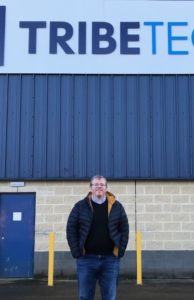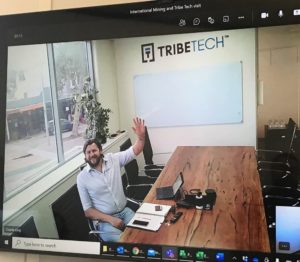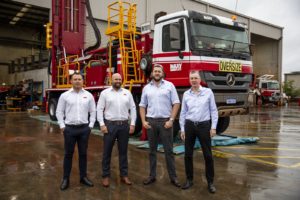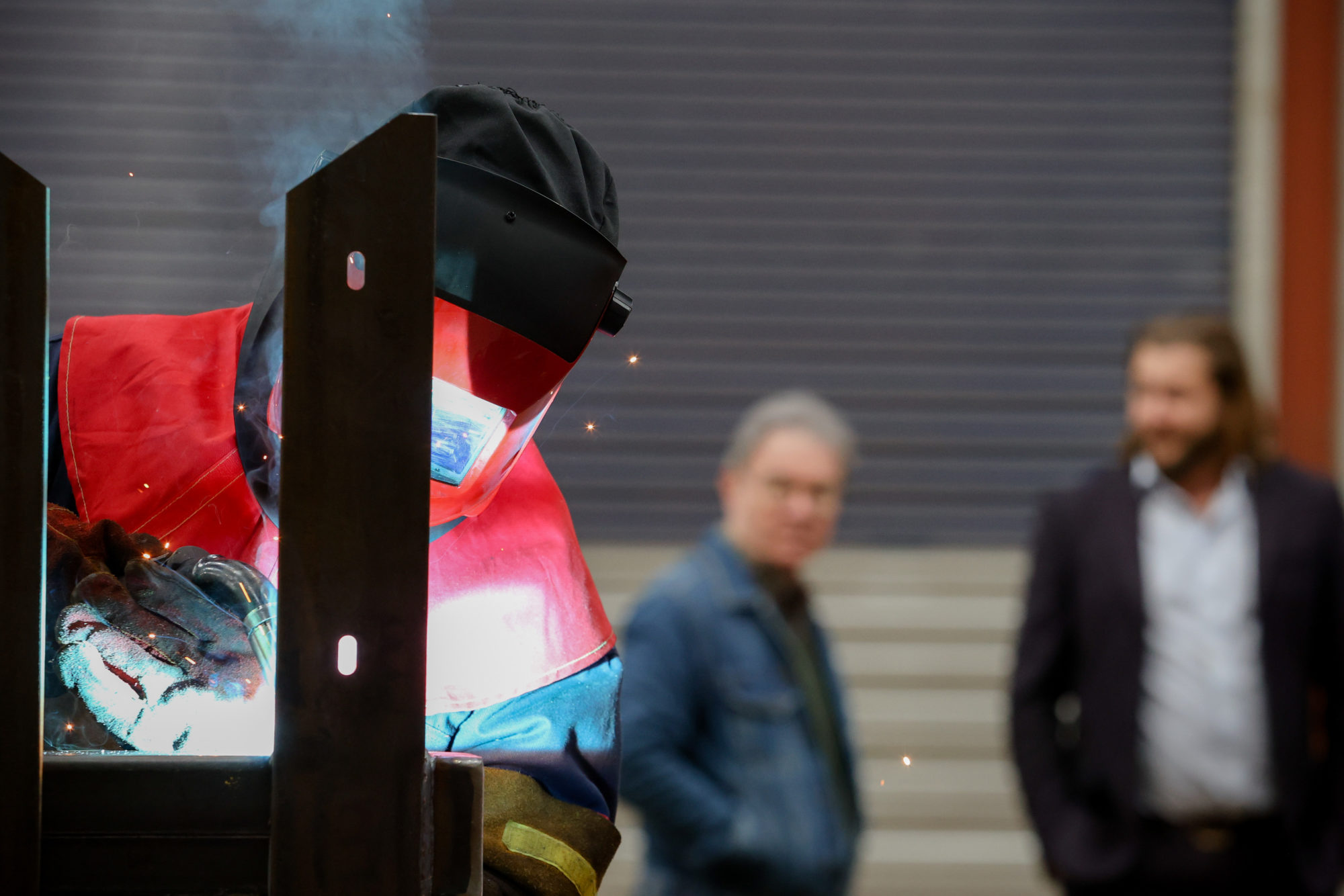IM Editorial Director Paul Moore visited the new Tribe Tech Group autonomous reverse circulation rig factory in Mallusk, just outside Belfast in Northern Ireland, to find out more about this remarkable start-up company, which has its second hub in Leederville, Western Australia, that has set out to totally revolutionise RC drilling with its Tribe Tech Drilling System (TTDS™) technology and initial TTDS GC 700 model.
Today, RC drilling still involves many manual elements, particularly with regard to processing the RC chip samples from the cyclone and being in proximity to compressed air, and to the mast, plus as RC is percussive – exposure to noise, dust and vibration – plus the risk of pinch points around the rig. They are also required to manually handle some of the downhole equipment, including bit and hammer changes plus rod handling and replacement of rods with damaged inner tubes from the rock chipping plus dealing with the heavy sample bags themselves. The extent of manual input is what makes it so difficult to automate in the first place and a major reason why it hasn’t happened until now.
On the investment front, Tribe Tech has also just recently secured a new round of significant series A funding involving private investors from both Northern Ireland and Australia, which has been match funded by Co-Fund NI, thought the amount has not been disclosed. Tribe Tech remains a private company, with the employees still owning the majority. R&D partner and global blasthole drill automation tech major FLANDERS is also involved as a partner. This latest funding follows almost £1 million from Invest NI, towards the creation of over 80 jobs. Tribe Tech’s Fiona McCartan, Supply Chain Manager was present at the office in NI, with Managing Director Charlie King joining from WA on a virtual call. The attached image shows Charlie King hosting the Australian Ambassador to Ireland, Gary Grey, on a March 2022 visit to the factory.
IM Editorial Director, Paul Moore at the factory in Mallusk, Northern Ireland

When will you finish the prototype and will you work with local quarry operators in Northern Ireland for testing and trials? Can you give more detail on launch customer McKay Drilling?
CK: We aren’t giving out a fixed release date but will say we are looking at shipping the first rig in 2022. We also have an agreement in place with a local quarrying company for a site where we can do some initial commissioning; but the rig will then see secondary commissioning once it arrives in Western Australia. We will be supporting the launch customer McKay Drilling, a Perth-based drilling contractor that is now part of Major Drilling, the world’s second largest contract drilling group. McKay have a solid reputation industry leaders in RC drilling, which is why we opted to partner with them – particularly they have expertise in deep hole RC and have been awarded numerous contracts for challenging projects that others would have had problems fulfilling. Our work with them will allow us to get the best possible data from our initial units in the field. McKay also have a lot of automation experience in-house already. They will be deploying the machine with a Pilbara Tier 1 iron ore miner client that will be the first to use the rig. Looking at the technology portion of the rig, we are already quite advanced with prototyping on the high risk elements of the design. Plus, even though the first machine will in effect still be a prototype, it will be a commercial sale and will signal the market availability of the model.
Can you provide any detail on the scale of the Mallusk factory in terms of capacity?
CK: We are not here to produce thousands of rigs, we are here to produce the best quality and above all safest RC rigs out there and the first with an autonomy focussed design – removing workforce risk while increasing drill time by 100%. Our technology testing and modelling so far have shown it has the potential to be 100 times safer and 70% more productive than conventional RC drilling rigs. The factory capacity will be akin to the future market demand for advanced and unmanned RC rigs. There is already a niche there among the most progressive and safety conscious drilling contractors and miners and we intend to fill that niche. But the RC industry won’t switch over to autonomy overnight, it will be a gradual ramp up.
There are already a large number of autonomous blasthole drill rigs operating – has mining company experience and success with those led to the demand in the RC sector?
CK: Absolutely – some of our customers already have experience with autonomous production drilling and have in-house autonomous operations teams. Plus we are partnering on some of the technology with FLANDERS, which has vast experience as an OEM agnostic supplier of autonomous production drilling technology through its ARDVARC fully autonomous control system. This has all brought learnings that make what we are doing possible. But it is also worth noting that there is a lot more complexity with RC compared to other drilling methods.

TribeTech MD Charlie King joining factory meeting from Perth office
Can you go into any detail on the autonomous elements that have been applied to the RC drilling sequence? What was easy and what was hard to automate? Are you looking at adding in-field sample analysis?
CK: Most of this is our core IP so is highly confidential – let me just say there is a huge degree of complexity in RC automation relating to the handling of rods and bits plus the cyclone sampling. You would typically have one or two people on the sampling; one person operating the rod handler; one person doing the actual drilling plus a supervisor plus maybe additional staff such as a geologist, health and safety professional or field assistant. We are very familiar with the challenges, however, due to projects our team members have worked on in previous roles; plus the sheer weight of engineering hours we have put into the TTDS development and the lessons we have learned along the way. I will say that a standard RC rig has three to five people operating it; whereas ours will have nobody on the drill pad at all and we have designed everything around that which has meant a colossal engineering project from the ground up. On sample analysis at the drillsite, not in our first generation design, but we do have some exciting R&D we are working on, but it won’t be available to the market with the initial rigs.
What is the background of the factory site and what equipment are you deploying to the facility in Mallusk?
FM: The site was initially used as a heavy manufacturing facility, which produced ducting and rebar. It offered everything that we needed for potential expansion, including two 10 t cranes. The facility allows space for the machinery to build three Tribe Tech Drilling Systems™, with room on site to ramp-up to up to at least six drilling systems. Our team of fabricators, fitters and electrical technicians will do most of the prototype build in-house and the drill rig will leave here complete and will be loaded onto a a roll-on/roll-off ship using its own power. The Mallusk area is a hotbed for manufacturing and is an easy commute for our employees from Belfast, Antrim and the surrounding areas. Our team is continuously expanding and the skill base in Northern Ireland has allowed us to work with not only with a great talent pool, but also with a high calibre of subcontractors. We work closely with local suppliers and subcontractors on everything from our steel chassis structure through to the mast and key components.
What role is FLANDERS playing in your partnership with them and how did the partnership come about?
CK: The arrangement remains one based on co-development of certain aspects of the TTDS technology. Senior management at both Tribe Tech and FLANDERS knew each other and realised that cooperation was a natural fit. They had been approached a few times over the years about autonomous RC drilling and nothing had been actioned yet both because they were focussed on growing their drill and blast business but also as automating RC was such as challenge – they saw we had a viable plan to do it so we went from there. It’s a win-win for both companies and we are also in talks with them about future projects as well. They are experts in the control side and we are allowing them to bring that into the RC drilling space. They have some great algorithms can are helping us accelerate our systems development. We have a highly skilled control systems team at Tribe Tech – we did have the capability to complete the whole project internally; but FLANDERS ARDVARC has been around for over 15 years so they have a lot of learnings and a lot of data so it really enhanced our project development while also accelerating it.
Left to right: McKay Drilling’s Chad McKay, Operations Manager & Aaron Earl, General Manager with TribeTech’s MD Charlie King and Chairman, Rod Houston at the McKay yard in Wangara, Perth

Are all the TTDS rigs going to be sold direct by Tribe Tech? Do you have a sense of the potential demand? Are the established drill OEMs not in this market as well?
CK: From a sales and marketing point of view, yes this will all be done initially by Tribe Tech. We certainly have no shortage of customer enquiries and have done in-depth market research that shows more than enough potential demand out there. We have also presold a significant number of the rigs. On the existing OEMs, they know they are working on solutions but we believe and from what we have been told we are bringing better technology to market faster. And we have invested millions of dollars specifically in our TTDS rig development, totally focussed on autonomous RC, whereas for others it is just one project of many. Also I would highlight our team – we really do have a handpicked group of high calibre industry specialists; plus the backing and support we have had from the drilling industry itself who want the solution out there in the market, exemplified by our relationship with McKay Drilling. Another point is how our unmanned drill will help drilling contractors manage their mining client expectations in a market where there are serious shortage of experienced drillers. There are plenty of drills out there but not enough skilled people to operate them. Ultimately, contractors will be able to use a small group of upskilled individuals to monitor operation of multiple autonomous RC drills – that’s the aim.
FM: This is a new and exciting concept and is ahead of anything that is currently on the market in terms of engine power. It is also extremely robust, weighing in at 65 t. It is designed to cope with challenging conditions and to prevent RC drill stalling, which is a common problem within RC drilling. In comparison to any other established drill OEMs, Tribe Tech’s design and autonomous element has redefined mining. It offers a big reduction in maintenance needs and because the rig is unmanned, it improves both efficiency and safety in the mining sector.
Why set up your manufacturing base in Northern Ireland, when you are thousands of miles away from the launch market? What still made it attractive despite logistics costs? How would you grow your presence if markets develop elsewhere?
CK: We weighed up the pros and cons of various locations around the world. First and foremost we wanted to produce a very high quality product, and were happy to spend a bit more on labour costs to help us guarantee that. The UK infrastructure is fantastic plus it has a favourable central timezone and high shipping frequency. It is well located for accessing potential markets not only in Australia but also in South America and Africa. Roll-on roll-off shipping of mining equipment around the world from Northern Ireland is very established due to the mobile crushing and screening industry centred there which also brings a long history of mining equipment manufacturing and the associated skills sets. And of course in Australia have our engineering and service location. In the future, when we move into new markets we will also look to start up satellite facilities in those regions focussing on in-country field support, local service engineers and spare parts. In terms of NI to Australia logistics, it has been affected to some extent by the global supply chain re: lead times for parts for example, but this problem is worldwide. But we had ordered bulk components very early on so avoided most of this.
FM: Again, the skill base in Northern Ireland is vast and is home to some of the UK’s most innovative and exciting businesses. Growth in the Northern Ireland manufacturing sector has grown four times faster than the rest of the UK and we want to be a big part of that growth. We have access to some of the best subcontractors in Antrim, mid-Ulster and beyond and we are excited to provide an opportunity for these businesses to be partners in an international company. We don’t see distance as an issue as our rigs are autonomous and we will see a constant stream of data from each rig allowing us to troubleshoot any issues and provide quick solutions to our customers. All our rigs come with maintenance manuals and critical spares, which means that any small issues can be fixed quickly and effectively on-site. We are also working locally with some of the best freight forwarders who are used to shipping heavy machinery and equipment worldwide from Belfast. We can assign more costs to logistics due to what we have saved by manufacturing the rig in Northern Ireland, but surprisingly, it is similar in price to ship a rig from Northern Ireland to Perth than it is to ship it on from Perth to a mining site in Western Australia.











